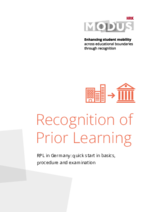Recognition of prior learning
The recognition of competences acquired outside higher education institutions ensures better permeability between the academic and other education systems, such as vocational education and training. It can be an important instrument for opening up higher education institutions to new target groups and serve to improve equal opportunities. Furthermore, permeability is also of great importance for academic continuing education and lifelong learning, especially in times of a shortage of skilled workers and rapidly changing demands of the digital world of work.
In contrast to higher education recognition, which refers to competences or achievements made at higher education institutions, recognition of prior learning presupposes the equivalence of achievements in terms of content and level when it comes to examination. In contrast, higher education recognition focuses on the concept of a substantial difference in the acquisition of competences.
The aim of recognition of prior learning is not to test competences that have already been acquired more than once and, if necessary, to shorten study periods in a quality-assured and meaningful way. The competences may have been acquired in different educational contexts: formal, non-formal or informal. The higher education institutions are obliged to credit competences acquired outside of higher education in accordance with the respective state higher education laws, as a rule up to 50 percent of the study credits.
A basic approach is provided by the publication Recognition of prior learning at Higher Education Institutions: Organisation - Implementation - Quality Assurance of the HRK's nexus project (in German).
Regulations
At the level of the Länder, the respective State Higher Education Acts regulate the recognition of prior learning. To implement this, the higher education institutions must anchor the corresponding regulations in their study and examination regulations. The formulations in the state laws are based on a number of resolutions and specifications, e.g. those of the KMK or the Accreditation Council.
Accreditation specifications also contain regulations on crediting competences acquired outside higher education, such as in the Musterrechtsverordnung (MRVO) § 9 "Special criteria for cooperation with non-university partners":
"[T]he higher education institutions [...] are responsible for the quality assurance [...] of the recognition procedures for competences acquired outside higher education. Only those competences that are equivalent in terms of content and level to the part of the study programme that is to be replaced can be credited. In this context, such knowledge and skills acquired outside higher education may replace a maximum of 50% of a higher education study programme. [...]."
Equivalency assessment
In contrast to recognition of higher education qualifications, recognition of prior learning presupposes the equivalence of the achievements in terms of content and level. Qualification frameworks, in particular the Qualification Framework for German Higher Education Qualifications (HQR) (german only), or other reference systems such as generic taxonomies of learning (e.g. according to Anderson and Krathwohl) can be used to check equivalence, which is based on learning outcomes. The Module Level Indicator (MLI) of the Carl von Ossietzky University Oldenburg also offers assistance in preparing decisions for recognition of prior learning. You can find out more about the application of the MLI on pages 85-91 of the publication “Die Gestaltung durchlässiger Bildungsangebote durch Anrechnung beruflicher Kompetenzen auf Hochschulstudiengänge” by Dr. Wolfgang Müskens (in German).
Recognition of prior learning procedures
In the design of recognition of prior learning procedures, a distinction is generally made between individual and flat-rate procedures:
Individual recognition of prior learning: On the basis of the documents submitted by the student, it is examined whether and to what extent the competences or knowledge and skills acquired outside of higher education are equivalent to parts of the degree programme in terms of content and level and can thus replace them. The equivalence is always checked on a case-by-case basis.
Lump-sum recognition: In this type of recognition, a specific qualification, e.g. a training programme, is compared with the degree programme by a panel of experts. Applicants who can provide evidence of this qualification can then receive credit for the corresponding modules without an individual examination. This form of credit is independent of the person.
Further information
Why recognition of prior learning is worthwhile for potential students is shown in the video portrait of the recognition of prior learning competence area at Carl von Ossietzky University Oldenburg.
In addition to a wealth of information on the subject of recognition of prior learning, the central information platform DAbeKom (in German) at Bielefeld University of Applied Sciences also offers nationwide services for individual and lump-sum recognition of prior learning of vocationally acquired competences to higher education degree programmes, both for graduates and for providers of vocational education and training on the one hand and for higher education institutions on the other.
How the terms recognition and recognition of prior learning are differentiated, what reasons there are to dedicate oneself to credit transfer as well as what challenges and opportunities credit transfer offers for higher education institutions, is explained in a video series (in German) that was created within the framework of "Open Higher Education".
Definition
In the German higher education system, recognition of prior learning (RPL) refers to competences and qualifications that have been acquired outside higher education institutions and are recognised with the aim of taking up or shortening studies at higher education institutions. The competences may have been acquired in different, i. e. formal, non-formal and informal, contexts. RPL helps to avoid a double examination of competences that have already been acquired and to shorten study periods in a quality-assured and meaningful way creating space for further studies, care work or other activities. For competences to be recognised, their equivalence to respective study modules is checked according to content and level. When designing RPL procedures, a distinction is made between individual, lump-sum and combined procedures.

